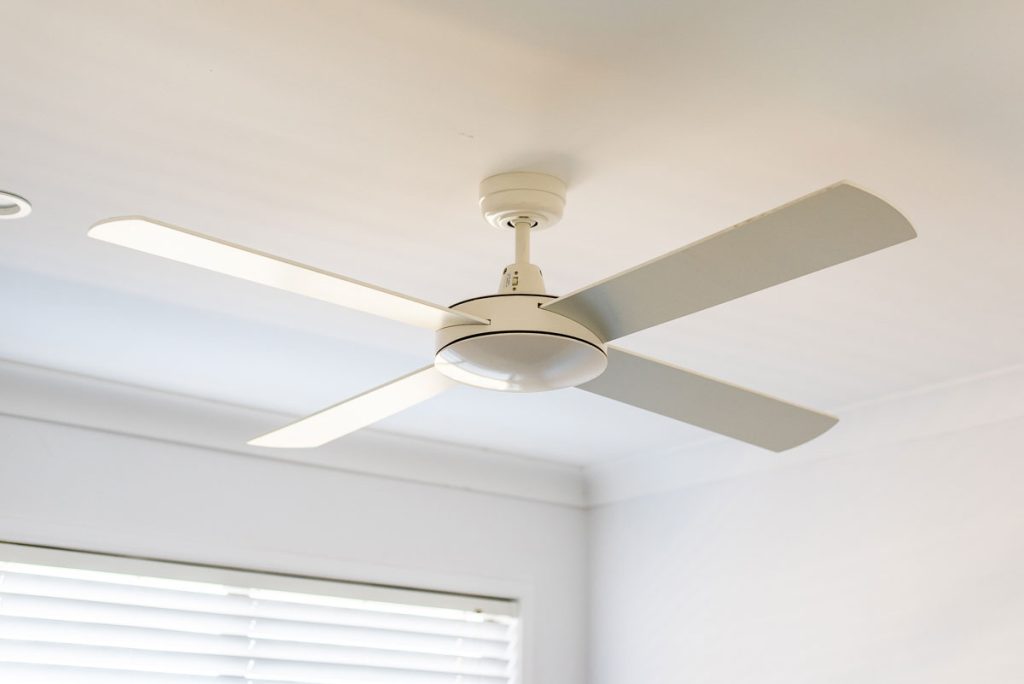Brisbane’s summers make staying cool a full-time job. It can be expensive to run your air conditioning 24/7, which is why most of us turn to ceiling fans.
Ceiling fans are an affordable and efficient way to beat the heat. When they’re working properly, ceiling fans are effective and almost silent. But, when something’s wrong, ceiling fans can make some pretty annoying noises.
A ceiling fan that is making clicking, grinding or humming noises shouldn’t be ignored. These are a symptom of a bigger problem, and you may need to replace the fan if you don’t address the underlying cause soon. In this article we’ll look at some of the most common ceiling fan noises and what you can do to fix the issue.
Common Ceiling Fan Noises
1. Clicking or Tapping Noises
Ceiling fans making clicking noises is one of the most common complaints we hear. Clicking and tapping noises are usually caused by loose fan blades, wobbly components, electrical issues or a loose light fitting.
2. Grinding Noises
Grinding noises are caused by a motor that needs attention. Ceiling fan motors and bearings need to be oiled from time to time. Switch off your fan and call an electrician if you hear a grinding noise. Running the fan while it’s grinding can damage components and may turn a simple repair job into a replacement.
3. Humming Noises
Humming noises are commonly caused by electrical issues in the fan. This problem may be more obvious if your fan has a light that’s connected to a dimmer switch. You’ll need to speak to an electrician to diagnose and repair an electrical issue.
4. Scraping Noises
Most scraping noises are caused by the canopy coming loose and rubbing against the ceiling or downrod when the fan is in use. Check the canopy to see if it’s loose or wobbly.
How to Fix a Noisy Ceiling Fan
1. Clean the Fan
Ceiling fans often get neglected. They’re up high and hard to reach, so they probably don’t get cleaned as often as the rest of your house. But, if you’re hearing a strange noise, the first thing you should do is clean the fan.
Fans that are covered in caked-on dust don’t perform at their best. This dust can also unbalance the fan and cause all sorts of strange noises. You can use a vacuum cleaner to remove most of the dust, but you’ll probably need to use a damp cloth and warm water to get rid of stubborn deposits.
2. Inspect the Fan
With the fan clean, it’s time to inspect the unit. Turn the fan on and watch it carefully for any obvious defects. If you can’t see anything, turn it off and grab your ladder. When inspecting a fan you should be looking for signs of:
- Loose screws
- Wobbly fan blades
- Excessive movement in the fan motor
- Damage such as cracks and warping
3. Tighten Any Screws
Ceiling fans are shipped disassembled. They come in a few distinct parts that need to be bolted together during installation. Using a ladder, check the screws that hold the fan blades onto the motor.
These screws should be fastened tightly. If any of the fan blades are noticeably loose, try tightening the screws and see if that gets rid of the clicking noise.
4. Look for Wobbly Fan Blades
Once you’ve checked the blades to make sure the screws are tight, turn the fan back on and look for wobbly blades.
Wobbly blades are a sign that the fan is unbalanced. This can cause a clicking noise and will shorten the lifespan of the bearings and motor. If you notice wobbling, check each blade for signs that it’s bent, cracked or damaged. Cracked and damaged blades are especially common on outdoor fans with timber blades that are exposed to the weather.
Contact the manufacturer to order replacement blades if you find any obvious damage.
5. Check the Canopy Cover
The canopy is the decorative cover that hides the wiring between the ceiling and the fan. These covers can come loose over time and they may be the cause of clicking or scraping noises.
Climb up your ladder and see if you can wiggle the canopy. The canopy should fit snugly. Tighten the screws if they’re loose. Some canopies are held on with a small collar that can be rotated to tighten the cover.
6. Call an Electrician
A ceiling fan that makes clicking, tapping or grinding noises needs attention. If you don’t address the issue, internal components and wiring may become damaged, and you’ll need to replace the entire unit.
You can avoid that expense by calling an electrician. Your electrician will be able to disassemble the fan and find the source of any strange noises.
It’s important to leave ceiling fan work to a qualified professional. Ceiling fans are connected to mains power and can cause serious electric shocks. Clicking noises can sometimes be caused by loose or damaged electrical connections, so it’s better to leave maintenance to the pros.
Get Your Ceiling Fans Ready for Summer with Dawson Electric!
If you live in a hot climate, ceiling fans are your best friend! Ceiling fans are an excellent way to improve air circulation and reduce your power bill without sacrificing comfort. Except for when they make funny clicking noises.
With summer on the way, now’s the best time to have your ceiling fans inspected by Dawson Electric! Dawson Electric is a residential electrician that works throughout Brisbane. Our electricians are qualified to install, service and repair ceiling fans, so we can take care of any strange noises your fans are making.
Contact us today if your ceiling fans are making a clicking noise. We’ll diagnose and fix the issue so you don’t have to worry about that click-click-click all summer!


